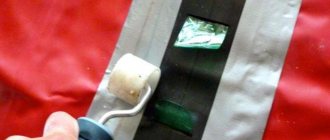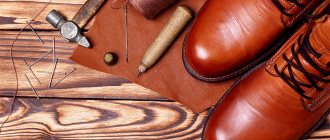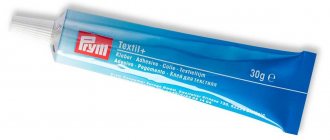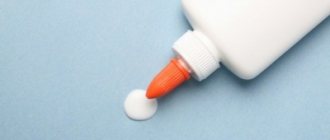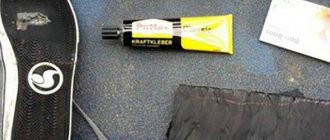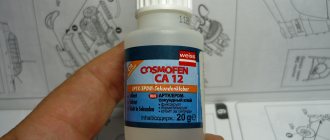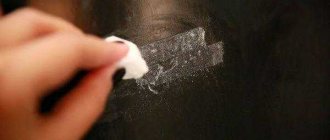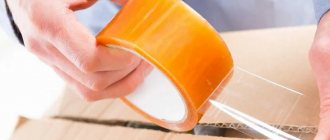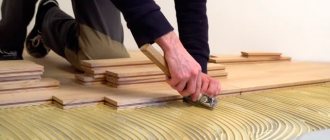Composition and characteristics of Desmokol glue
This glue contains an organic solvent, polyurethane resins and modifier ingredients. Product Main Features:
- Dismacol glue has a transparent texture, so the places where it was applied will not stand out against the background of the rest of the material.
- The composition is resistant to moisture. It can be used to glue materials with humidity levels up to 25%. Desmokol polyurethane adhesive is suitable not only for repairing shoes, but also for repairing rubber boats, fishing and hunting equipment.
- The universal mixture does not deteriorate at low temperatures and does not crack under the influence of mechanical loads.
- This glue is extremely convenient to use, because... it dries quickly.
- The connection made with this glue is reliable and durable.
- A seam made using Desmokol shoe glue is not only strong, but also extremely elastic.
The glue is sold in different states and packs. For household purposes, it is better to take compact tubes with a volume of 50 ml or 1 liter containers. In industry, glue is used in tanks with a volume of 20-200 liters.
This adhesive composition is also available on sale in the form of granules. Before use, they must be diluted with a solvent.
Release form
Desmokol is sold ready for use. It can be in 50 ml tubes (Fig. 1), 1 liter metal cans (Fig. 2), or in granular consistency. For industrial purposes, the product is usually purchased in 20 liter buckets or 200 liter barrels. The granular type must be additionally mixed with a solvent, such as acetone. The quality of the finished compounds depends on the degree of purification of the added substance.
Rice. 1 – glue in a tube
Rice. 2 – glue in a jar
Since the composition contains flammable components, all work is carried out away from fire and sparks.
Instructions for use Desmokol
Where and how is Desmokol glue used?
This glue has an extremely wide range of applications. It is used for fastening:
- PVC parts;
- any types of thermoplastics;
- polyurethane;
- rubber.
In the manufacture and repair of shoes, glue is also used for stitching. It is often used to attach polyurethane and polyvinyl chloride soles to fabrics. In addition, the product is excellent for bonding metal, glass, plastic and leather.
How to properly glue shoes with Desmokol?
The instructions for use of this adhesive product state that the surface must be properly prepared before using it. Preparation involves the following steps:
- first, all contaminants must be removed from the surface;
- after this, the remnants of the old adhesive mixture are removed from the material;
- additionally, the coating must be treated with fine-grained sandpaper;
- At the final stage it is necessary to degrease.
Desmokol shoe adhesive must be applied to both surfaces that will stick to each other. After application, it should be left for 5-10 minutes to dry completely. If the mixture is absorbed into the structure of the material, it must be applied a second time and again wait 2-3 minutes. The product should completely “set”, as a result of which a glossy film should appear on the treated area.
After this, using a hairdryer or any other heating device, you need to heat the treated surfaces to +80°C and press them firmly together.
A high-quality adhesive product immediately forms a strong connection that does not require the use of clamps, vices or other weights for auxiliary compression. You can use taped shoes after 24 hours.
How to pour and what to dilute the glue with?
Desmokol polyurethane adhesive can be poured from a canister or jar into any plastic bottle. But at the same time it is necessary to screw the lid tightly, because... pressure is generated in the container, which will not lead to rupture of the vessel.
If preference was given to a granular product, then pure acetone must be prepared to dilute it. The components are mixed in a ratio of 1:10, i.e. 20 g of adhesive granules should be added to 200 ml of acetone.
Dilution must be carried out at air temperatures within +25…+30°C. The granules are placed in acetone and left in it for 6-8 hours. During this period, the granulated product should completely swell, forming a solution with a heterogeneous consistency. The working mixture must be thoroughly mixed until it becomes liquid.
Experienced shoemakers add Desmodur to the adhesive mixture. This modified composition allows you to give the repaired boots or shoes additional strength and resistance to temperature changes.
Adhesive “SAR 306” Thermoactive, polyurethane (1 kg, black)
Attention!
According to the Decree of the Government of the Russian Federation dated January 19, 1998 No. 55, household chemical goods are not subject to exchange or return.
SAR 306 adhesive
is a thermoactive polyurethane adhesive with good resistance to high temperatures. It is intended for leather goods production, but many people use it for reupholstering interiors. Apply with a brush or spatula; to use in a spray bottle, dilute the glue with Molecule solvent.
● Manufacturer KENDA FARBEN (KENDA FARBEN) Italy. ● Consumption of 1 can is approximately 3-5 sq.m. with one-sided single-layer application. ● The adhesive works in the temperature range from -40 to +80 °C ● After application to both surfaces to be bonded and drying, the glue is activated with a hair dryer at a temperature of about +80 °C, the temperature is set on the hairdryer from 150 to 600 °C, and the glue is applied to the surface, warms up from a distance of 5 to 50 cm from the nozzle; the distance from the hair dryer nozzle to the adhesive layer and the temperature of the hair dryer are selected in such a way as not to burn the material and at the same time activate (liquefy) the glue.
APPLICATION OF GLUE:
● Apply SAR 306 adhesive to carefully prepared surfaces and allow to dry for 15-20 minutes at room temperature. Reactivate at 70-80 °C with a hairdryer. Quickly connect and press under pressure of 4-6 kg/cm2 for 10 seconds. Final bonding occurs after 24 hours. ● It is advisable to degrease the working surface with Molekula thinner-cleaner. ● Adding 3-5% Kendor S activator to SAR 306 adhesive can improve the adhesion of any surfaces and, in particular, all difficult-to-glue materials that have a high amount of plasticizers in their structure, such as SBR-TPR-PVC-PU-PA-ABS, fatty leather , HIIYTREL, etc. ● Use glue at a temperature not lower than +18°C. If the product is stored in a cold room, it is necessary to bring the temperature of the glue to +18°C before starting work. ● Solvent content in accordance with existing standards. We ignite.
If the working surface is plastic marked PP/PE, then to stick the material onto such a surface you need to use polychloroprene adhesive SAR 30-E.
Attention !
All information about adhesives on our website is based on the practical experience of specialists and is reliably presented by us. However, we have no control over the methods and conditions under which the adhesives we sell are used, the work performed, or the final product produced by the customer. Therefore, we cannot accept responsibility for buyers' results. Responsibility for determining the suitability of the adhesives we sell for the buyer's purposes rests entirely with the buyer. All conditions, representations, representations, warranties, implied or statutory regarding any goods sold or supplied by us are satisfied and we shall not be liable for damage to or loss of property, applicable to any property arising directly or indirectly from the use of our products or goods.
Are there any analogues to Desmokol?
If it is impossible to purchase this adhesive mixture, then you can select its substitutes. Among the most popular formulations, 3 products stand out:
- Polyurethane shoe adhesive SAR 306. This product is excellent for gluing plastic and leather surfaces. They must be used according to the instructions, observing safety rules, because... SAR glue contains toxic substances.
- Nairit. This product is often used to repair fabric, leather and plastic products.
- I-900. This product perfectly withstands the influence of acids, alkalis and other aggressive substances.
- POLING-170. This mixture is used to repair PVC, rubber, fabrics, metal alloys, glass, plexiglass and plastic.
Peculiarities
In comparison with similar products, Desmokol glue has 6 advantages:
- The composition is transparent, the gluing area after the repair remains unnoticeable. This makes it possible to restore things or shoes, giving them their original appearance.
- Glue is not afraid of water. The universal product connects surfaces whose moisture content does not exceed 25%. Therefore, “Desmokol” is used for repairing hunting and fishing equipment (suitable for gluing patches on rubber boats).
- The composition does not crack or crumble under the influence of loads when the air temperature drops to 0 °C.
- The glue is practical to use. It takes some time for Desmokol to dry completely. This makes it possible to adjust the connection location.
- Durability and strength of joints. Materials glued together using the composition form a single whole.
- The connection is durable and elastic. Shoes after repair do not cause discomfort.
The disadvantages of Desmokol glue include flammability, since the product is solvent-based.
See also
How to properly glue a rear view mirror and choosing the best product
Storage and safety precautions
The adhesive product must be stored at a temperature within +10...+25°C. In this case, it will retain its characteristics for 1 year.
When using the product, you need to take into account that it contains flammable and toxic substances, so you should not work with it near flame sources. In addition, repair work using this product should be carried out in a well-ventilated area. If the mixture accidentally gets on your skin, it should be washed off as soon as possible, otherwise irritation may occur.
Useful tips
Several recommendations that will allow you to handle Desmokol correctly:
- Glue in granules must be diluted with a solvent. It is best to use acetone. For this purpose, 1 part of the granules is mixed with 10 parts of acetone. Typically, 20 grams of glue take 200 milliliters of solvent. The resulting mixture is kept for 7 – 8 hours. To make the process faster, you should maintain the room temperature within 25 - 30 degrees above zero. The result is a colorless solution. The composition is thoroughly mixed until a homogeneous mass is obtained.
- An additive called “Desmodur” improves the quality of the glue. It is added to Desmokol at the following rate: for 1 part of glue, 15 - 20 parts of additive. As a result, the thermal stability of the glue and the strength of the seam it forms improves.
Scope of application
The main area of use of the product is shoe repair. It can firmly bond leather to leather, artificial materials, nubuck, and shoe fabric. You can also connect the fabric base to the inside of the shoes, glue heel caps, and attach outsoles. It is acceptable to glue zippers instead of sewing them in.
Among other things, it is possible to use a means for fastening any parts from:
- rubber;
- wood;
- metal;
- felt;
- plastic;
- glass;
- ceramics;
- porcelain.
Using the material, you can stick construction decorations onto the base - moldings, plastic corners, tiles. The highest quality is produced in cans; it is this that connects the parts most reliably. Adhesives in tubes are used for those products that are subject to less friction and pressure (for example, boot tops).
